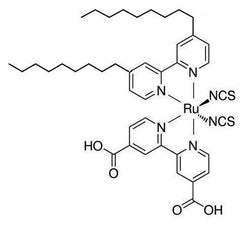A ruthenium complex
used as a dye in DSSCs for excellent thermal stability and high efficiency
Specifications | MSDS | Literature and Reviews
Z-907 dye, (cis-Ru(H2dcbpy)(dnbpy)(NCS)2, where the ligand H2dcbpy is 4,4′-dicarboxylic acid-2, 2′-bipyridine and dnbpy is 4,4′-dinonyl-2,2′-bipyridine, is amphiphilic in nature while the introduction of the two hydrophobic alkyl chains on the bipyridyl ligand is critical to provide an insulating barrier to avoid charge carrier recombination and also help enhance thermal stability.
It was reported that DSSC with Z907 and hexadecyl phosphonic acid adsorbing maintained 7% efficiency for as long as 1,000 hours ageing test at 80°C [1].
Ruthenium bipyridine complex
A high performance dyes used in DSSCs
Worldwide shipping
Quick and reliable shipping
Amphiphilic and stable
provides an insulating barrier to avoide charge carrier recombination
High purity
>95%
General Information
| Full name | cis-Bis(isothiocyanato)(2,2′-bipyridyl-4,4′-dicarboxylato)(4,4′-di-nonyl-2′-bipyridyl)ruthenium(II) |
| Synonyms | Ruthenium Dye Z907 |
| Chemical formula | C42H52N6O4RuS2 |
| Molecular weight | 870.10 |
| CAS number | 502693-09-6 |
| HOMO / LUMO | HOMO = -5.4 eV, LUMO = -3.8 eV |
| Solubility | Acetonitrile/tert-butanol (v/v = 1:1); DMSO |
| Classification / Family | Transition metal complex, Ruthenium complex, Bipyridyl ligands, Energy materials, Dye-sensitized solar cells DSSC) materials, Donor materials, OPV materials. |

Product Details
| Purity | >95% |
| Melting point | Melting point/range: 196 °C |
| Appearance | Black crystalline powder |
MSDS Documentation
Literature and Reviews
- Molecular-Scale Interface Engineering of TiO2 Nanocrystals: Improve the Efficiency and Stability of Dye-Sensitized Solar Cells, P. Wang et al., Adv. Mater., 15 (24) 2101-2104 (2003); DOI: 10.1002/adma.200306084.
- A stable quasi-solid-state dye-sensitized solar cell with an amphiphilic ruthenium sensitizer and polymer gel electrolyte, P. Wang et al., Nat. Mater., 2, 402 - 407 (2003); doi:10.1038/nmat904.
- High efficiency dye-sensitized nanocrystalline solar cells based on ionic liquid polymer gel electrolyte, P. Wang et al., Chem. Commun., 2972-2973 (2002); DOI: 10.1039/B209322G.

 Z907 Dye MSDS Sheet
Z907 Dye MSDS Sheet